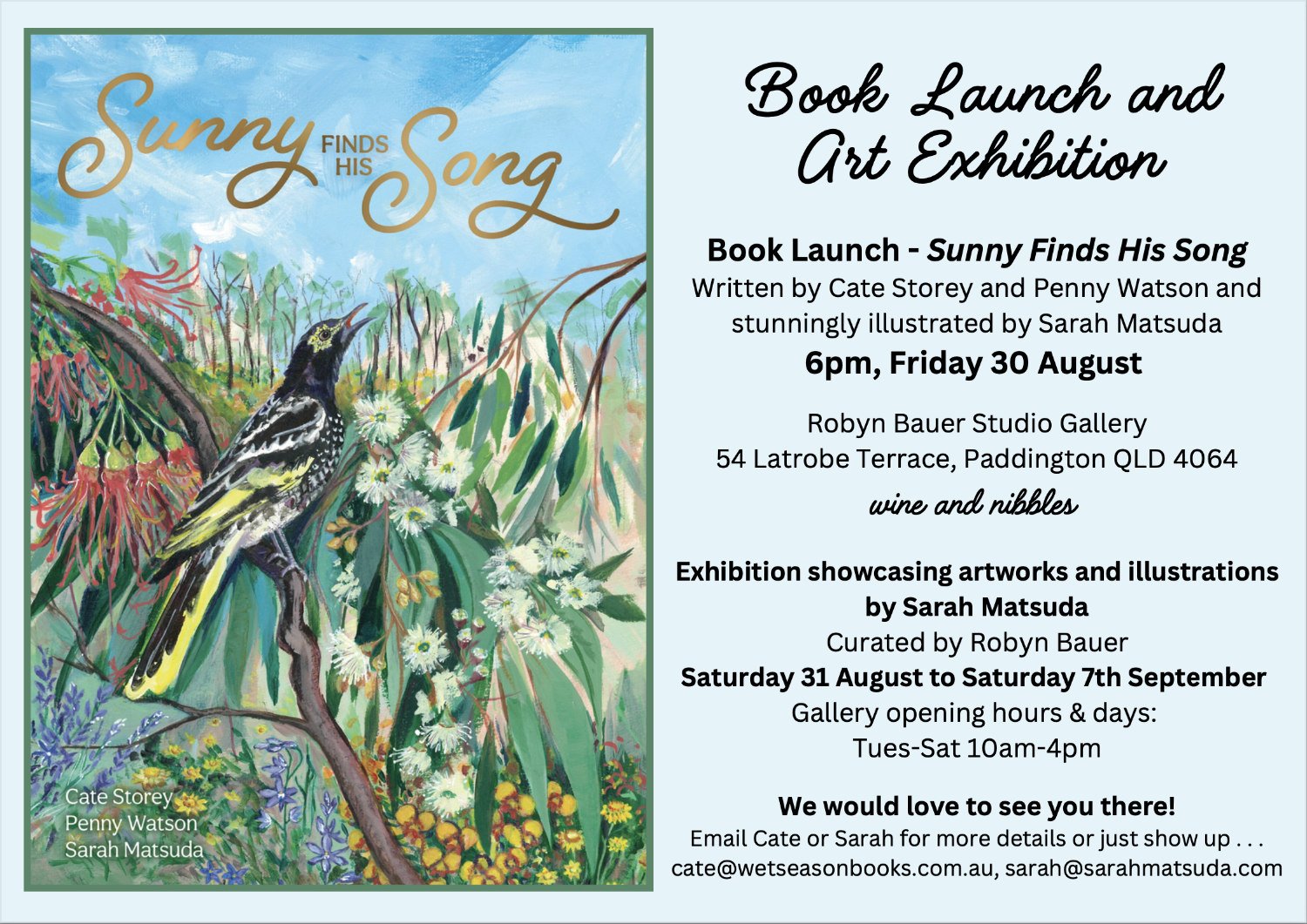Press Release - Sunny Finds His Song
New Children’s Book Highlights the Plight of the Critically Endangered Regent Honeyeater and Celebrates the Beauty of Australia’s Box-Ironbark Woodlands
A new children’s book, Sunny Finds His Song, shines a spotlight on the Critically Endangered Regent Honeyeater. This is the third collaboration between author Cate Storey and illustrator Sarah Matsuda, and the first children’s book by co-author Penny Watson.
The book will be officially launched at 6pm on Friday, 30 August, at the Robyn Bauer Studio Gallery, 54 Latrobe Terrace, Paddington, QLD 4064.
The event will also feature an exhibition of Sarah Matsuda’s original illustrations, which will run from Saturday, 31 August, to Saturday, 7 September.
Gallery opening hours are Tuesday to Saturday, 10am to 4pm.
Cate explains that the original story idea came from press coverage about Regent Honeyeater song-learning, which led the authors to articles published as part of Dr Ross Crates doctoral thesis. The authors extend their gratitude to Dr Crates not only for inspiring the story but for raising awareness about the Regent Honeyeater’s plight.
Regent Honeyeaters once flew in flocks across a range extending from Adelaide to Gladstone. However, habitat clearance has led the species to the brink of extinction, with only 300 birds remaining in the wild.
Regent Honeyeaters have a species-specific song which older male birds teach to older male birds.
Learning this song is crucial for attracting mates and defending territory. Regent Honeyeaters do not learn their song from fathers. Regent Honeyeater fathers remaining quiet during nesting to avoid predators, and the song-learning period only starts once young have left the nest area. As a result, young birds must find other tutors. With the population critically low, many young birds struggle to learn their song, sometimes imitating other bird species instead.
As it becomes harder and harder to pass the song between generations, the species-specific song is getting shorter and simpler over time. This process is referred to by Dr Crates as the loss of Regent Honeyeater song culture and is a significant challenge to the species survival.
Sunny Finds His Song, follows Sunny, a lonely Regent Honeyeater struggling to find others of his kind. Cate describes how the scientific backdrop of Regent Honeyeater song-learning provided the perfect setting for a gentle coming-of-age story. Despite the serious environmental themes, Sunny’s journey ultimately ends happily. He finds a singing teacher, a band of birds, and eventually, a mate named Goldie. Goldie’s leg bands reference real-life efforts to save the species through captive breeding and release programmes.
The book also highlights the importance of preserving habitats and feeding grounds for nectar-feeding birds. Regent Honeyeaters, nomadic in search of gum blossoms, are particularly associated with the often-overlooked box-ironbark woodlands. These woodlands are biodiversity hotspots, crucial for many species, including Regent Honeyeaters and Swift Parrots.
Australia has lost 70% of its temperate eucalypt woodlands. Box-ironbark country is also gold country. During the gold rush in the mid-1800s, box-ironbark woodlands were dug up in search of gold. Trees were cut down and used for building materials or were burned as firewood. After the gold rush, box-ironbark country continued to be cleared for firewood, farms and houses.
Woodlands on the fertile soil most suitable for farming were quickly cleared. Remaining woodlands now occur in less fertile places, where eucalypt trees grow more slowly and provide a less predictable supply of nectar. Older trees also provide a more predictable nectar source, and the amount of nectar they produce within a small space cannot be replaced by smaller and younger trees.
Cate, Penny, and Sarah hope that the story will get families talking about the value and importance of Australia’s eucalypt woodlands. “Because these woodlands once dominated our landscape, many of our species have evolved to depend on them, and I think woodlands are often overlooked when we think of habitat conservation,” Cate explains. She goes on to suggest, “The next time you are travelling, have a look out of your car window and observe what areas have been cleared and what remains. Of course, fertile plains have been mostly replaced by farmland because of their value for growing crops and grazing. But it was the very trees that grew on these fertile plains that produced the most reliable nectar supply.”
Cate also explains that intact and healthy box-ironbark woodlands are a delight for wildflower enthusiasts, with many wildflower treasures waiting to be discovered in the understory, such as native orchids and native pea flowers. These unique Australian wildflowers have been celebrated in Sarah Matsuda’s illustrations.
Cate, Penny, and Sarah would also like to acknowledge Mick Roderick, Woodland Bird Program Manager at Birdlife Australia; Allison Beutel and Jordan Mountney from Currumbin Wildlife Sanctuary; Dr. Daniel Appleby and Sara Petrovic for sharing their knowledge on the Regent Honeyeater; as well as Quentin Bel, Sue Brunskill, and Karen Retra for sharing their knowledge of Victorian wildflowers. A special thank you also to Mick Atzeni for recently taking Cate to see her first Regent Honeyeater in the wild, and Deb Metters for cultivating Cate and Penny’s love of birds.
For further information or to feature this article please contact:
Cate Storey - cate@wetseasonbooks.com.au
or Sarah Matsuda - sarah@sarahmatsuda.com


